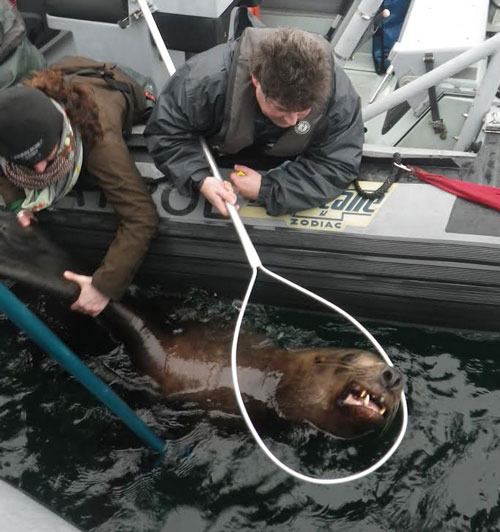By Cali Bagby
Island’s Weekly Editor
Rescuing a wild animal is no easy feat. Rescuing a 1,400-pound sea mammal is an entirely different feat.
A few weeks ago, Joe Gaydos found himself facing a Steller sea lion entangled by a piece of plastic packing strap off Fanny Bay in British Columbia.
“The biggest challenge when working with a 1,400-pound animal is obviously safety—for the people and for the animal,” said Gaydos, chief scientist and regional director of the Orcas-based SeaDoc Society, which conducts and sponsors scientific research in the Salish Sea. “You don’t want anybody to get hurt and you don’t want the animal to get hurt.”
Marty Haulena, the veterinarian at the Vancouver Aquarium who pioneered a popular disentanglement technique, has been training SeaDoc staff to disentangle animals. The rescue efforts include the remote injection of an anesthetic to sedate the mighty creature.
According to Gaydos, the beauty of the drug combination is that the animal will go under anesthesia enough to permit approach, but not so much that it stops breathing.
In the case of the sea lion, once it was sedate the team was able to cut the packing strap loose and reverse the anesthesia with an antidote, allowing the sea lion to swim away free.
According to Gaydos, “the Vancouver Aquarium and Department of Fisheries and Oceans have done this numerous times in British Columbia and animals have been re-sighted weeks to months after the disentanglement and have learned that the trauma heals quickly once the packing strap is removed and the sea lions gain weight and go back to looking like robust healthy animals in no time.”
The technique required a skilled team of boat drivers, biologists, veterinarians and veterinary technicians from the Vancouver Aquarium Marine Science Centre, the Department of Fisheries and Oceans and the Canada and the Seattle Aquarium.
Gaydos and Seattle Aquarium Veterinarian Dr. Lesanna Lahner are working with NOAA Fisheries to import the protocol into Washington and Oregon.
SeaDoc researchers have only attempted one disentanglement in Washington so far, and once the sea lion was darted with anesthesia, they discovered that the material had broken off and they were just seeing a scar.
Efforts are being made to find out what type of materials are most often entangling sea lions. Researchers plan to work with the companies that make these plastic materials strong enough to hold packed boxes, but will also rot and break free once in the water.
“We’ve done a lot of things to harm the ocean, which is a shame because it does so much for us that we ought to be taking better care of it,” said Gaydos.
He added that saving one sea lion from a slow strangulation is about making one wrong right, but sadly not all animals suffering this fate will be rescued.
“Hopefully this will remind people that trashing the ocean has consequences,” Gaydos said. “Maybe the next time they go to throw something off the boat they will reconsider and dispose of it properly. We owe it to the ocean.”




